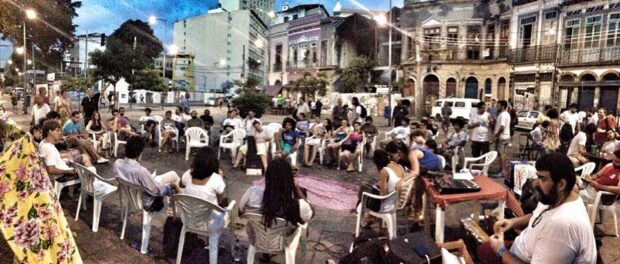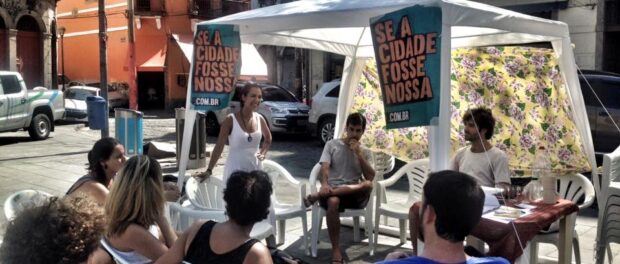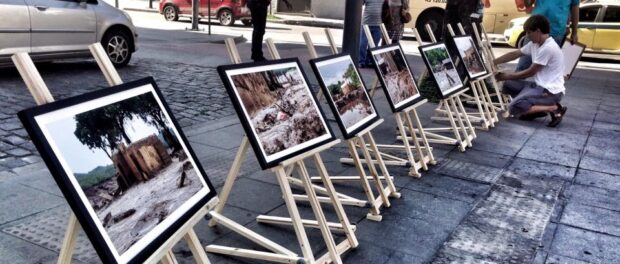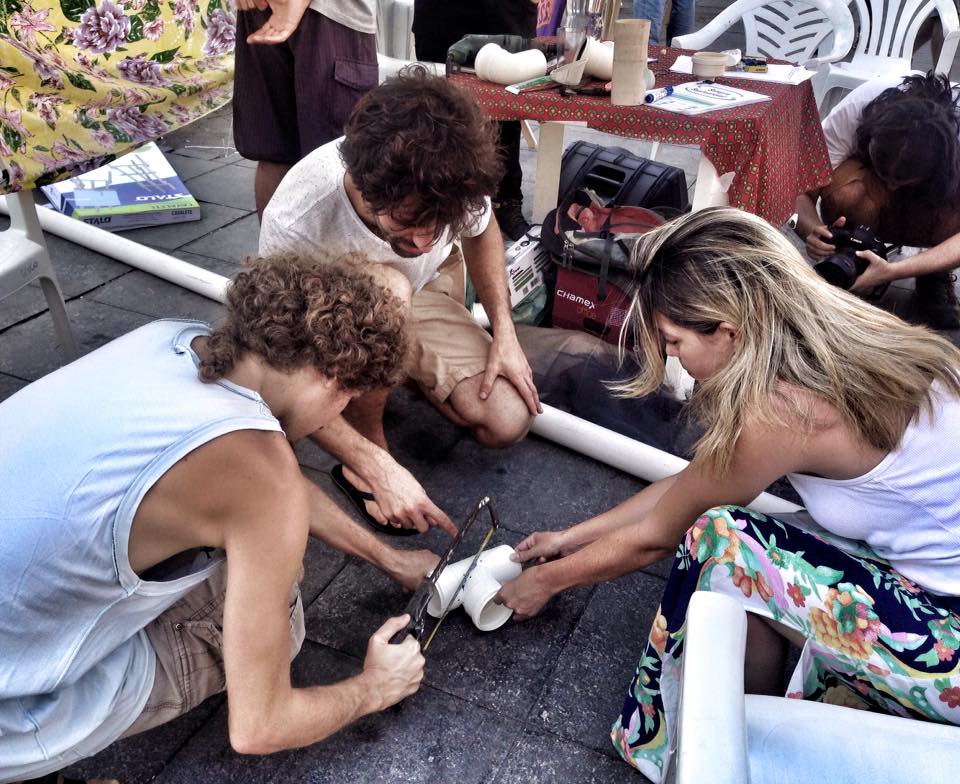
On Tuesday February 2, experts, activists, and community members gathered for the Encontro das Águas (Water Meeting) to discuss the water crisis in Rio de Janeiro. Hosted by the group Se A Cidade Fosse Nossa (If the City Were Ours) in the Port Region’s historic São Francisco da Prainha Square, the afternoon event began with a workshop on collecting rainwater led by the group Águas de Março (Waters of March), followed by a roundtable discussion between technical experts and citizens concerning the condition of water in Rio de Janeiro, and the night ended with a water-themed carnival street party Bloco das Águas. The event also featured a photography exhibit of the toxic mudslide disaster in Mariana by Daniela Fichino of the NGO Global Justice.
Águas de Março is a Rio-based collective focused on building and sharing low-cost rainwater collection technology. On Tuesday, representatives led an interactive workshop where they demonstrated their technology and some of the 25 attendees of this segment helped build a demo rainwater collection device, and “got their hands dirty,” as one of the leaders of the workshop put it.
Next, three water experts sat on an interactive panel attended by about 35 people. Environment researcher Flavia Braga Viera, sanitation engineer Stelberto Soares, who also used to work for state water utility CEDAE, and environmental education researcher Júlio Vitor gave short talks, eight community members responded, and the technical experts gave responses and closing remarks.
State of Rio’s Water
Flavia Braga Viera began the discussion with a call to end the commodification and monetization of water and a call to denounce the industrial consumption of water resources. She claimed that water distribution inequalities are a political concern rather than an environmental concern. She contextualized Rio’s water crisis, saying that although the water shortage has only come to the attention of most Rio locals in the past year, there has been a water problem for much longer.
Flavia continued explaining that historically, water was used individually, with each household fetching its own water. Since industrialization, water has gone through the process of commodification and privatization, and it became “blue gold, filled of economic value” with price increases due to the economics of changing supply and demand caused by droughts. Everyone using treated water must pay for it or risk getting their water shut off, and there are some who cannot afford the price of water, despite water access being a basic human right.
Since some Rio residents who can afford the higher prices of privatized water are experiencing water shortages for the first time due to weather conditions, public awareness of the problem is now growing, including recognition that some areas have never received water access at all even in times of non-drought, citing regions within the Baixada Fluminense. The current “crisis” is only for people using privatized water. For those still using artisanal, individually sourced water, water access has always been irregular. Hence, Flavia said that water distribution is not an environmental problem but a socioeconomic one: any technical solutions are beneficial only in the short term; long term problems with water can only be solved politically.
She noted the industrial usage of water and inefficiencies: “CEDAE loses about 40% of its water input. Also, although industry loses a vast quantity of its water input, they pay less than individuals who use only a fraction of what industry uses. Turning off the faucet while brushing one’s teeth or taking short showers is part of the solution, but addressing large-scale inefficiencies is more beneficial for society.”

State of Sanitation in Rio
Stelberto Soares addressed some technical aspects contributing to the water crisis and sanitation in the city. He began with the statistic that of the 86 water treatment areas in Barra de Tijuca, only six function correctly. Historically, CEDAE treatment centers had a loss of 70% of their input, but today that number has decreased to about 30-37%, he said.
Stelberto explained that the city of Rio de Janeiro sources its water from the Paraíba do Sul, the largest river in Rio state, and from Minas Gerais state through a tunnel system. 40% of water in Rio de Janeiro is treated at the Guandu treatment plant, the biggest water treatment plant in the world. However, Guandu is losing fresh water due to contamination by sea water in a feedback cycle caused by the water shortage. CEDAE can’t take as much water out of the Paraíba do Sul, consequently there is less fresh water ejected into the Guanabara Bay by Guandu, so seawater encroaches more easily back into the plant.
Next, Stalberto explained that water can be contaminated at every step of the process from source to faucet. The tunnel systems, storage tank, and filter are all possible sources of contamination.
Stelberto shared an alarming statistic about water treatment in the city: Rio de Janeiro collects 56% of its sewage, 86% of which is officially treated. However, that “86%” incorporates all official treatment centers, functioning or not, so in Barra da Tijuca where only six treatment areas actually function, the remaining 80 are counted officially, meaning that the percentage of sewage treated in Rio is radically lower.
Furthermore, the City’s treatment strategy for sewage-polluted rivers misses the point, Stelberto says. When a river is contaminated with sewage from homes which aren’t connected to an official treatment plant, it all eventually runs into the ocean. To address this, the city has built multiple sewage treatment plants at the mouths of rivers. Stelberto instead recommends updating the infrastructure so sewage never makes it into the river in the first place. In theory, the City has the capacity and responsibility to provide 200 liters per resident per day, which does not come to pass for some communities.

Critical Environmental Education
Júlio Vitor spoke next about the different types of environmental education, claiming that “critical” environmental education can address issues most effectively, repeatedly requesting that some favela residents who have excellent first-hand knowledge of water management be invited to the next water panel.
The classic type of environmental education is “conservationist” education, which Júlio jokingly referred to as “tree huggers.” Students are taught that uninhabited wilderness must be preserved. Júlio cited one of his professors who criticizes NGOs operating under conservationist thought, who go into favelas teaching residents how to reduce their water use, even though those communities may not have dependable access to a water source, effectively telling people with no water that they have a responsibility to use less water.
The next type of environmental education that Júlio touched on was “pragmatist” education, making ecological systems more efficient to increase their output.
The last main type he discussed was “critical” environmental education which has an ecological and social focus. For example, to answer the question “why do some people have water and some don’t?” someone with a critical environmental education background would say the issue is not a technical question. The way society currently looks at the water crisis is wrong, he argued, and agreed with Flavia’s argument that industrial use of water is more of an issue than even heavy personal use.
Júlio talked about the community Morro da Formiga, the favela where his research is based, and used them as an example of excellent community water management. To address their lack of municipal water access, they built their own water infrastructure and manage it to this day with various Water Societies that meet weekly. They have strong community-based environmental education with local experts like Seu Francisco, head of a water society, and Amadeu Palmares da Silveira who have learned from years of hands-on experience. Júlio called for the next panel to include favela residents like them.
Júlio went on to explain that some favela communities in the West Zone feel that their water is being taken and diverted to Barra da Tijuca and recognize the injustice. They work in neighborhoods like Barra where they see houses with swimming pools, yet they get criticized for deforesting and taking water from the forest to meet their basic needs, Júlio said. To tackle these issues, the environmental justice aspect of water shortage and sanitation must be addressed.
At this time, the sun had set and a group of about 50 had gathered to listen to the wide range of community responses. One speaker called for activist political groups to collaborate and fight for a solution. Another speaker proposed a more delicate community response, happily stating that “water has no problem at all, the problem with water is us.” A notable speaker was Julieta, a young girl who expressed her unhappiness at seeing a polluted waterfall on a family vacation.
The speakers gave closing remarks addressing the community responses, and the event turned into a carnival bloco with a live band performing, closing the first in a series of Se a Cidade Fosse Nossa events related to the environment.

